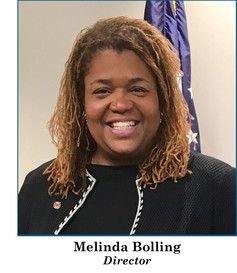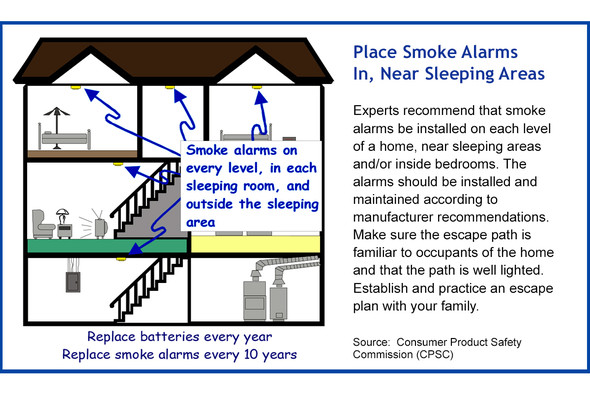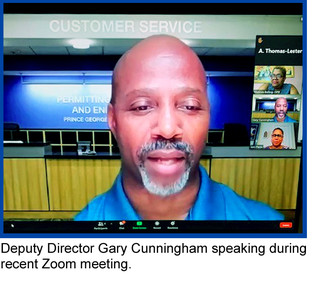

Make Sure Your Happy Home is Also Healthy and Safe
Recent news reports about deck collapses and injury fires point to the importance of proper home maintenance and keeping your home adequately equipped with safety features. Maintaining your house protects your family and your investment. In this issue, DPIE staff members discuss procedures to maintain your home — from keeping your HVAC filters clean to ensuring your smoke and carbon monoxide detectors are operational. As we note below, problems won’t disappear — they get worse if ignored. It is important to establish a home maintenance plan, conduct periodic inspections to identify problems, then make needed repairs or hire qualified professionals to do so.
DPIE helps property owners to maintain their homes by enforcing property maintenance codes. Ensuring your lot is free of trash makes it look nice, but it also helps prevent rodents that can bring disease and filth and eat away at features inside your house. Keeping downspouts and gutters free of debris keeps properties aesthetic pleasing and keeps stormwater from pooling improperly. Visit the DPIE website for additional information.
Stay cool and safe!
|

DPIE Associate Director Behdad Kashanian has some advice for homeowners interested in protecting their investment: make sure to perform routine home inspections and maintenance to ensure longevity and prevent expensive repairs down the road.
Gone unchecked, leaky roofs, broken sprinkler heads, clogged pipes and other problems can lead to property damage inside and outside.
“Homeowners should establish a schedule to check for problems and when issues are found, they should take action to repair them,” Kashanian said. “You should not ignore home maintenance issues.”
Inspector Joe Busby, whose team inspects properties for permits, compared home maintenance to health care.
“If you don’t take care of your health, you will fall apart. If you don’t take care of your house, it will fall apart, as well,” Busby said.
Busby focused on five areas for routine home inspection:
Decks: Decks should be inspected at least once each year to ensure boards and diagonal bracings are intact; handrails are sturdy; the wood underneath remains firm; nails have not pulled back; joists, posts and headers are holding the deck properly; and the ledger board that keeps the deck mounted to the side of houses is in good working order.
Walls and foundations: Check walls and foundations regularly for cracks. Cracks can indicate a problem with foundations or moving roof trusses. Nail pops also occur when roof trusses move, but typically are not a cause of concern, Busby said, adding, “A contractor can nail them back or put in screws, but that won’t stop some of them.”
HVAC: Busby suggested changing filters every quarter and having your HVAC system inspected and serviced annually to make sure heating coils and interior and exterior condensing coils are clean, Freon is at the appropriate level and not leaking and the system is blowing properly.
Water heater: Flush your water heater every other year to clear out water. Rust and sediment pool in the bottom and eventually will rust through the mechanism and flood your basement or the flooring under the water heater.
Painting and caulking: Interiors and exteriors should be painted at least every five years to prevent wood rot from seeping water.
 

Interior Checklist:
1. Control moisture to prevent mold and mildew. Mitigate mold and mildew when discovered.
2. Keep air (dust) filters clean to protect your HVAC system and have it checked periodically.
3. Check floors — especially around sinks, toilets, doors and windows — to ensure they are firm.
4. Check seals around doors and windows.
5. Check sprinkler heads for dampness and corrosion. Replace any with problems and flush the sprinkler system occasionally.
6. Check for cracks in walls and foundations and uneven door jambs and have them evaluated to determine if they are caused by structural problems.
7. Check electrical outlets with a tester (about $10) to ensure they are in good order.
8. Check for leaking water pipes.
9. Drain and flush your water heater periodically.
10. Seal (caulk) around windows, doors, tubs, sinks, kitchen counters, etc. to prevent leaks and water damage.
|

Exterior Checklist:
1. Replace rotted wood around windows and doors inside and outside of your house.
2. Repair or replace leaky roofs.
3. Keep branches, vines and roots away from structures when possible to prevent damage to the brick or siding. Replace loose bricks or siding when needed.
4. Refrain from placing large trees near homes to prevent root interference with foundations or pipes.
5. Check for evidence of rodents, insects and other pests and have them mitigated if detected. Prevent pests by keeping your lot free of trash.
6. Keep drains and areas around basement doors clear of debris to prevent flooding and make sure your sump pump is working.
|
 
Smoke Alarms
Statistics from the U.S. Fire Association (USFA), a division of FEMA, show that fires caused 3,704 deaths, 16,600 injuries and $14.8 billion in financial loss in 2019. According to the USFA: “A smoke alarm is critical for the early detection of a fire in your home and could mean the difference between life and death. Fires can occur in a variety of ways and in any room of your home. But no matter where or how, having a smoke alarm is the first key step toward your family’s safety.”
Many homes where injury fires occur lack working smoke alarms.
"People often disconnect smoke alarms because they are annoyed by the noise they can make when triggered by smoke during cooking," said Enforcement Division Inspector Calvin Saunders, a retired Prince George's firefighter. "Others fail to check the batteries frequently, so the alarms don’t work when needed."
There are a number of options for smoke alarms. Ten-year smoke alarms have built-in batteries. Hard-wired smoke alarms are connected to a power supply and have battery backups. Interconnected smoke alarms allow all alarms in a structure to sound off if one is activated. Firefighters recommend replacement of smoke alarms older than 10 years.
For those who still have older battery-operated smoke alarms, check the batteries regularly and change them twice a year — when daylight savings time starts in the fall and ends in the spring.
"Remember to establish and practice an escape plan with your family," Saunders said.
The Consumer Product Safety Commission (CPSC) website shows that the majority of fatal fires occur during sleep hours.
“A smoke alarm stands guard around the clock. . .. This often allows a family the precious, but limited, time needed to escape,” according to the CPSC website.
Carbon Monoxide Detectors
Often called the invisible killer, carbon monoxide is an odorless, colorless gas created when fuels such as gasoline, wood, coal, natural gas, propane, oil, and methane burn incompletely. In the home, heating and cooking equipment that burn fuel are potential sources of carbon monoxide (CO), according to the National Fire Protection Association (NFPA) and the CDC. Vehicles or generators running in an attached garage can also produce dangerous levels of carbon monoxide.
• Infants, pregnant women, and people with physical conditions that limit their body's ability to use oxygen can be more severely affected by lower concentrations than healthy adults.
• A person can be poisoned by a small amount of CO over a longer period of time or by a large amount over a shorter amount of time.
• Each year more than 400 Americans die and 20,000 are treated in emergency rooms for unintentional CO poisoning not linked to fires.



The Department of Housing and Urban Development (HUD) recommends the following steps to make your home healthier.
1. Keep it dry: Prevent water from entering your home through leaky roofs and foundations. Check your interior plumbing for leaks.
2. Keep it clean: Control dust and contaminants. Reduce clutter and use effective cleaning methods.
3. Keep it safe: Store poisons out of the reach of children and properly label them. Secure loose rugs and keep children's play areas free from hard or sharp surfaces.
4. Keep it well ventilated: Ventilate bathrooms and kitchens and use whole house ventilation to reduce the concentration of contaminants in the home.
5. Keep it pest free: Seal cracks and openings throughout the home and store food in pest-resistant containers. If needed, use sticky-traps and bait in closed containers or low-toxin pesticides.
6. Keep it contaminant free: Reduce lead-related hazards in pre-1978 homes by fixing deteriorated paint and keeping floors and window areas clean. Test for radon gas, and install a radon removal system if levels above the EPA action-level are detected.
7. Keep it maintained: Inspect, clean and make needed repairs to your home routinely.
8. Keep it thermally controlled: Houses that do not maintain adequate temperatures may place the safety of residents at increased risk from exposure to extreme cold or heat.
Source: HUD website
|
 

The Fall 2021 Community Partners' Meeting will take place virtually via Zoom at 9:00 a.m. on Thursday, September 23, 2021. The meeting will include presentations from DPIE, the Department of the Environment (DoE) and the Department of Public Works and Transportation (DPW&T). Questions for each agency may be submitted in writing on the "Community Partners' Meeting Question Form." Submit your form and RSVP to tlcollins@co.pg.md.us by August 24. Questions will be answered by agency officials. Answers will be presented at the meeting and posted on each of the departments' websites.
|

 |
|
DPIE Congratulates Eric Hall
Employee of the Month for August 2021
Eric Hall is a Construction Standards Inspector II in the Site Development Section of the Inspections Division. He is being recognized for superior performance. Eric reads and interprets approved engineering plans, conducts field inspections and interprets codes on a senior level. This allows him to keep his sites in compliance and bring them to completion in a timely manner. Eric is excellent with customers and positive with coworkers. Eric goes above and beyond in performing his job duties, is excellent with customers and is praised by his coworkers.
|
DPIE commends you for your exceptional performance!


|